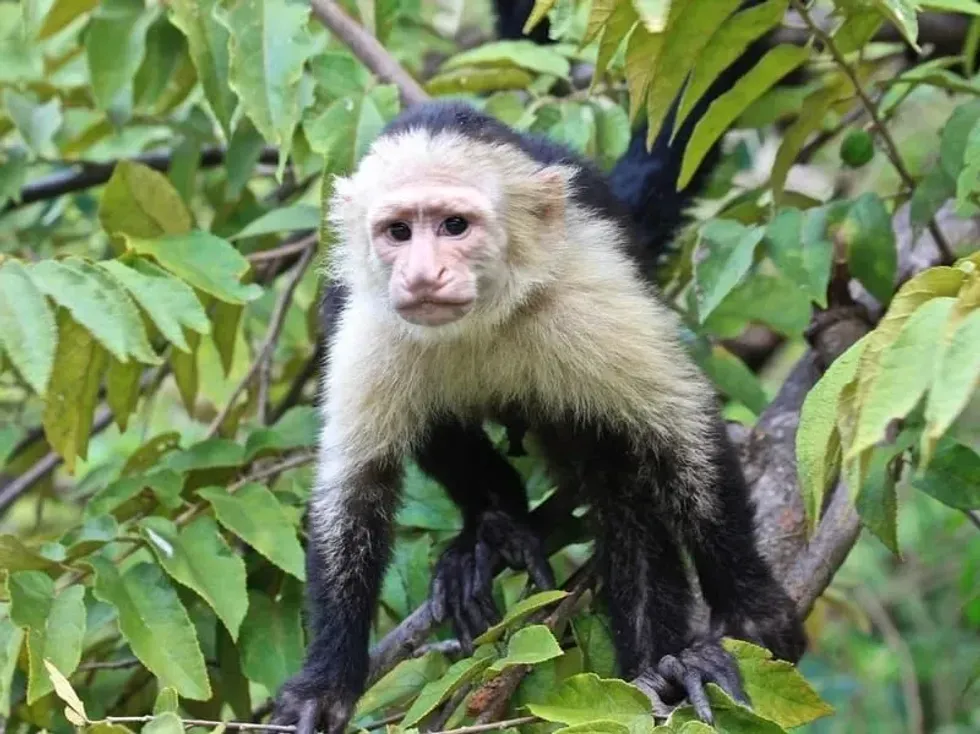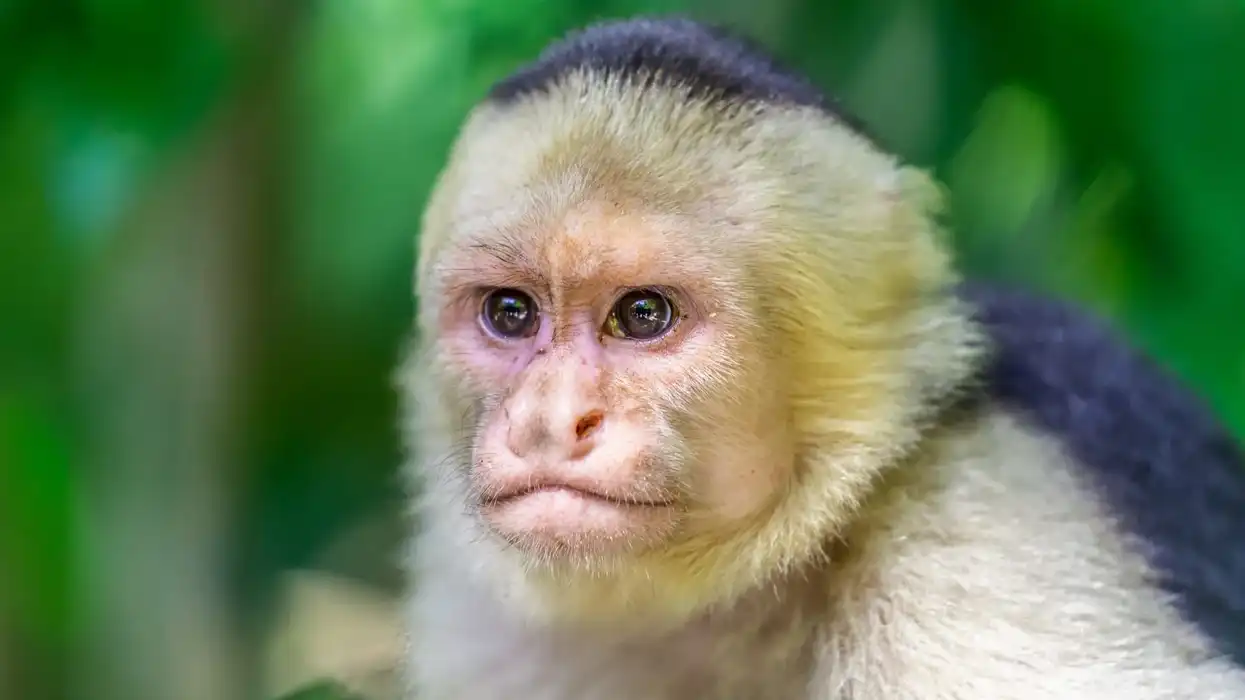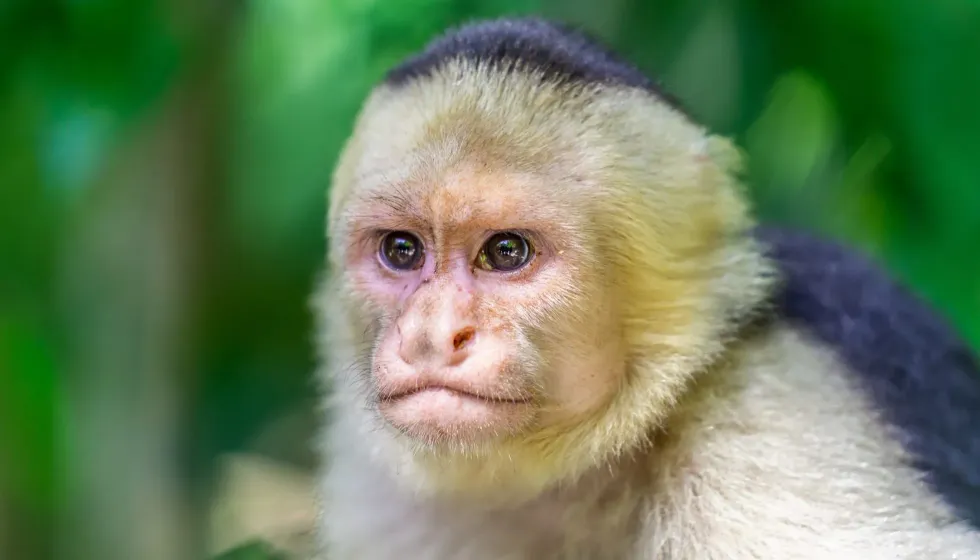Fun Panamanian White Faced Capuchin Facts For Kids

Content
- What type of animal is a Panamanian white-faced capuchin?
- What class of animal does a Panamanian white-faced capuchin belong to?
- How many Panamanian white-faced capuchins are there in the world?
- Where does a Panamanian white-faced capuchin live?
- What is a Panamanian white-faced capuchin's habitat?
- Who do PPanamanian white-faced capuchins live with?
- How long does a Panamanian white-faced capuchin live?
- How do they reproduce?
- What is their conservation status?
- What do Panamanian white-faced capuchins look like?
- How cute are they?
- How do they communicate?
- How big is a Panamanian white faced capuchin?
- How fast can a Panamanian white-faced capuchin move?
- How much does a Panamanian white-faced capuchin weigh?
- What are the male and female names of the species?
- What would you call a baby Panamanian white-faced capuchin?
- What do they eat?
- Are they loud?
- Would they make a good pet?
- Did you know...
- The Panamanian white-faced capuchin's characteristics
- Do people keep Panamanian white-faced capuchins as pets?
The Panamanian white-faced capuchin is a medium-sized species from the Cebidae family and Cebinae subfamily. Also known as Cebus imitator, Central American white-faced capuchin, and Panamanian white-headed capuchin, this New World monkey is native to the forests of South America and Central America.
The Panamanian white-faced capuchins are also known for dispersing seeds and pollens which makes them important for the rainforest ecology.
Some might recognize the Panamanian white-faced capuchin monkeys as the companion to the organ grinder, musical novelty performers from the 19th or early 20th century. In the past few years, they have become quite popular in the Northern American media, especially because of the Pirates of the Caribbean series.
The Panamanian white-faced capuchin monkeys are an intelligent species that can be trained to assist a paraplegic person. It is mainly black but has a white and pink face.
Most of the front part of its body is also white. It has a prehensile tail that it carries coiled up. This tail supports the white headed capuchins when they are feeding beneath a bench.
You may also check out uakari facts and howler monkey facts from Kidadl.
Panamanian White-Faced Capuchin Interesting Facts
What type of animal is a Panamanian white-faced capuchin?
The Panamanian white-faced capuchin is a New World monkey from the Cebidae family and Cebinae subfamily. Also known as the white-throated capuchin or the white-faced capuchin, it is a medium-sized primate that comes from the tropical forests of Central America, especially in Costa Rica and Panama.
It can also be found living in South America’s extreme northwestern parts and the deciduous forests on the Pacific coast. These New World monkeys play an important role in dispersing pollens and seeds which makes them crucial to rain forests.
They are an intelligent species that can be trained to provide assistance to paraplegic people. They have been quite popular in the North American media in recent years.
What class of animal does a Panamanian white-faced capuchin belong to?
The Panamanian white-faced capuchin Costa Rica monkeys belong to the mammal class of animals.
How many Panamanian white-faced capuchins are there in the world?
The last count of the Panamanian white-faced capuchin was done in 2007 when there were about 54,000 of them in existence. According to the IUCN, their conservation status is Least Concern.
However, because of threats like deforestation, the population of the Panamanian white-faced capuchin is decreasing. There are certain breeding programs at various wildlife preserves and zoos to boost their population.
Where does a Panamanian white-faced capuchin live?
Panamanian white-faced capuchin monkeys can be found in South America and Central America, specifically in tropical forests of Panama, Colombia, and Ecuador. There are troops of monkeys living high in the tree canopies where they can hide from predators, find food, and communicate with other capuchin monkeys from their groups.
The Panamanian white-faced capuchin needs a climate with high humidity levels to survive. You will often see a Panamanian white-faced capuchin sticking its tongue out. They do it to allow the moisture to evaporate and stay cool during a dry season.
What is a Panamanian white-faced capuchin's habitat?
The habitat of a Panamanian white-faced capuchin is a tropical forest, mostly in Central and South America. These are warm habitats that get lots of rain every year during the wet season.
But, they also have dry seasons when there is little to no rain. Overall, a tropical forest is a rich habitat that supports great diversity including a large number of animals and plants.
Who do PPanamanian white-faced capuchins live with?
The Panamanian white-faced capuchins from the genus Cebus is a very social animal that lives in a group with an average of 15 capuchin monkeys, the majority of which are females. Their social groups can consist of related female capuchins, offspring, and immigrant males.
On average, the females give birth every 26 months, but they mate throughout the year. The infant usually stays at their mother's back.
The female capuchin tends to stay in their original group whereas the male capuchin leaves their natal group at the age of four years and then changes the group every four years. Both males and females of this species exhibit dominant behaviors in the group.
How long does a Panamanian white-faced capuchin live?
The Panamanian white-faced capuchin monkey's lifespan is 15-25 years.
How do they reproduce?
The Panamanian white-faced capuchins, from the genus Cebus, have a polygamous mating system where a male can mate with several female white-headed capuchins. However, studies have shown that even though the dominant alpha male capuchin does not monopolize breeding, they do tend to father their young.
Also, even though a female capuchin can mate with multiple mates, she will copulate with the dominant male at peak fertility.
There is evidence showing that the dominant male white-headed capuchins avoid breeding with their daughters who are troop members. Such characteristics are very rare for a New World primate.
Just like other species of capuchin, the Panamanian white-faced capuchin matures slowly as well. They reach sexual maturity at the age of three years. On average, the female capuchin will give birth the first time at the age of seven years and then every 26 months thereafter.
The male capuchin gains reproductive maturity at the age of 10 years. Given their size, the Panamanian white-faced capuchin has a long life span. The maximum recorded lifespan of a Panamanian white-faced capuchin in captivity is 54 years.
What is their conservation status?
According to the IUCN, the Panamanian white-faced capuchin is of Least Concern in terms of conservation standpoint. However, since it is often captured for the pet trade, its numbers are declining. Its habitat has also suffered a lot of harm because of deforestation.
Panamanian White Faced Capuchin Fun Facts
What do Panamanian white-faced capuchins look like?

Panamanian white-faced capuchins from the family Cebidae are known to have white fur on their face and chest and black fur on their legs and back. Mainly found in Central American tropical forests, they have a cap of black fur on their head.
An adult male capuchin can weigh about 8 lb (3.6 kg) whereas the female usually weighs only 5 lb (2.2 kg). The Panamanian white-faced capuchin grows up to be somewhere between 13-17 in (34-45 cm) in length.
This length doesn’t include their tail which is almost the same length as their body.
The Panamanian white-faced capuchin also has a prehensile tail which means that they can use it for grabbing objects like branches. It is like their third hand.
With their tail, they are able to hang on to branches and tree limbs while moving through the treetops. By staying on the high branches, they are able to avoid predators.
How cute are they?
With their black and white fur, the Panamanian white-faced capuchin does have a very cute appearance.
How do they communicate?
Panamanian white-faced capuchin uses loud calls like barks and coughs for communicating threats and soft calls like squeals for communicating in initiating discourse. Different kinds of threats like a threat from a bird versus a threat from a terrestrial animal will involve different vocalizations. Scents and facial expressions are also an important part of communication.
How big is a Panamanian white faced capuchin?
The length of the Panamanian white-faced capuchins can be between 13-17 in (34-45 cm). Its tail is longer than its body which can be about 22 in (55 cm).
How fast can a Panamanian white-faced capuchin move?
The fastest speed of a Panamanian white-faced capuchin, Cebus Imitator, that was recorded is 34 mph (55 kph).
How much does a Panamanian white-faced capuchin weigh?
The average weight of Panamanian white-faced capuchins is between 6.4-8.6 lb (2.9-3.9 kg).
What are the male and female names of the species?
Males and females are called Panamanian white-faced capuchins, they have no sex-specific names.
What would you call a baby Panamanian white-faced capuchin?
A baby Panamanian white-faced capuchin is called an infant.
What do they eat?
Panamanian white faced capuchins are omnivorous. Their primary foods are insects and fruits and they forage at every level of the forest as well as on the ground.
To find food, they strip the bark off of trees, break dead tree branches, use stones for cracking hard fruits, roll over rocks, and search through the leaf litter. It has a prehensile tail that helps with feeding and provides them support while they are foraging for food.
About 50% to 67% of their diet is made up of fruits. Some of their favorite fruits are mangoes and other fruits from the Anacardiaceae family, figs from the Moraceae family, fruits from the Rubiaceae family, and bean-like fruits from the Leguminosae family.
The Panamanian white-faced capuchin only goes for ripe fruits. It tests its ripeness by smelling, prodding, and tasting the fruit. It eats only the juice and the pulp and spits out the fibers and the seeds.
It also eats plant matter such as young leaves, flowers, bromeliads, and seeds of certain plants. It uses the bromeliads for water as well by drinking the water trapped inside it.
They also eat insects such as butterflies, moths, caterpillars, beetle larvae, ants, and wasps. It can eat larger prey as well such as birds, frogs, mollusks, crabs, lizards, and small animals.
Are they loud?
A Panamanian white-faced capuchin is known for its loud screams that they use for long-range vocalizations.
Would they make a good pet?
You might see an infant monkey and find it almost irresistible to not pet them. A baby Panamanian white-faced capuchin appears so helpless, sweet, and almost like a human infant.
However, it is important to remember that those babies will grow up to become adult monkeys that are very difficult to handle and are not good pets. They are aggressive and can be dangerous, especially when they reach sexual maturity.
Taking care of a pet monkey is a lot different than taking care of other pets. The lifespan of a Panamanian white-faced capuchin is between 15-25 years which means they need your full commitment. They won’t grow up and start behaving like mature adults. They will be toddlers that are just big in size.
Also, a pet Panamanian white-faced capuchin might not be very welcoming to new people including your spouse and children. This will make it hard for you to go on vacation. Finding a new home for your capuchin won’t be as easy as finding someone to dog sit. This can be psychologically hard on the capuchin.
Furthermore, a Panamanian white-faced capuchin will need a lot of social interaction. If you are not able to provide them with the time and attention they need, they might develop severe behavioral problems such as biting and screaming along with some psychological issues that are difficult to treat.
Did you know...
That the Panamanian white-faced capuchin has many predators, just like most small animals. They are hunted by eagles, ocelots, caiman, jaguars, eagles, and snakes (lancehead snake and the tree boa constrictor).
Almost all of these predators can access the trees easily where the Panamanian white-faced capuchin lives. An eagle might swoop down to attack them or a jaguar might follow them up a tree to eat them. The Panamanian white-faced capuchin might climb down to get water from a watering hole and end up getting captured by a caiman.
The first defense these new world monkeys have against their predators is running. Sometimes, all the members of their troop gather together and try fighting off the intruding predator. Another threat faced by the Panamanian white-faced capuchin is habitat loss because of deforestation.
Also, they are hunted by humans to be sold as exotic pets. Even with this, the conservation status of the Panamanian white-faced capuchin monkey remains of Least Concern. They have a stable population, but efforts are being made to protect them.
The Panamanian white-faced capuchin's characteristics
A Panamanian white-faced capuchin monkey can be often seen sticking its tongue out. However, they are not being rude with this. They stick their tongue out so that the moisture can evaporate. This helps them stay cool, especially during a dry season.
Do people keep Panamanian white-faced capuchins as pets?
Since the Panamanian white-faced capuchin is a primate, it might be illegal to have them as a pet in some areas. Even if it is legal to own one, you might still need a permit.
Sometimes, permit holders have to go through home inspection to prove that they have the proper facilities and can provide care for the Panamanian white-faced capuchin. Another issue is that your homeowner policy might require liability coverage.
Some insurance companies can even cancel your policy if they find out that you have a pet monkey. Without insurance, you will be at risk, especially if your pet monkey bites someone.
Medical issues are also the reason why keeping a Panamanian white-faced capuchin as a pet might be difficult. There are several zoonotic diseases that can be passed between humans and monkeys.
Also, keeping a captive monkey healthy is quite difficult. For example, monkeys need a specialized diet that is not only expensive but also time-consuming to prepare. If they eat a poor diet, then they might get diabetes which will require constant monitoring by a veterinarian.
Overall, they are not a good time. Having them for a while might seem not a big deal, but the truth is that they are capable of damaging a lot and causing too much harm. They need too much attention and care to live in a human household. They normally cost $7,000.00 (USD).
Here at Kidadl, we have carefully created lots of interesting family-friendly animal facts for everyone to discover! Learn more about some other mammals from our gray mouse lemur facts and Old World monkeys facts pages.
You can even occupy yourself at home by coloring in one of our free printable Panamanian white-faced capuchin coloring pages.
We Want Your Photos!
More for You
See All
Bachelor of Science specializing in Mass Communication.

Adekunle Olanrewaju JasonBachelor of Science specializing in Mass Communication.
Disclaimer
1) Kidadl is independent and to make our service free to you the reader we are supported by advertising. We hope you love our recommendations for products and services! What we suggest is selected independently by the Kidadl team. If you purchase using the Buy Now button we may earn a small commission. This does not influence our choices. Prices are correct and items are available at the time the article was published but we cannot guarantee that on the time of reading. Please note that Kidadl is a participant in the Amazon Services LLC Associates Program, an affiliate advertising program designed to provide a means for sites to earn advertising fees by advertising and linking to Amazon. We also link to other websites, but are not responsible for their content.
2) At Kidadl, we strive to recommend the very best activities and events. We will always aim to give you accurate information at the date of publication - however, information does change, so it’s important you do your own research, double-check and make the decision that is right for your family. We recognise that not all activities and ideas are appropriate for all children and families or in all circumstances. Our recommended activities are based on age but these are a guide. We recommend that these ideas are used as inspiration, that ideas are undertaken with appropriate adult supervision, and that each adult uses their own discretion and knowledge of their children to consider the safety and suitability. Kidadl cannot accept liability for the execution of these ideas, and parental supervision is advised at all times, as safety is paramount. Anyone using the information provided by Kidadl does so at their own risk and we can not accept liability if things go wrong.
3) Because we are an educational resource, we have quotes and facts about a range of historical and modern figures. We do not endorse the actions of or rhetoric of all the people included in these collections, but we think they are important for growing minds to learn about under the guidance of parents or guardians.







